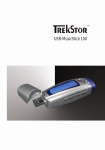Download IPBRICK Installation Manual
Transcript
IPBRICK Installation Manual February 2006 2 c Copyright iPortalMais All rights reserved. February 2006. The information in this document could be change without further notice. The declarations, technical data, configurations, and recomendations of this document are supposedly precise and reliable, but they are presented with no expressed or implicit warranty. IPBRICK - 2006 Contents 1 Purpose of this document 5 2 Before begining 7 3 IPBRICK installation 3.1 Assumptions . . . . . . . . . . . . . . . . . . . . . . . . . . . . . 3.2 Installation Procedure . . . . . . . . . . . . . . . . . . . . . . . . 3.3 Error Messages . . . . . . . . . . . . . . . . . . . . . . . . . . . . 9 9 9 11 4 Managing the IPBRICK 4.1 Network configuration . . . . . . . . . . . . . 4.2 Connecting to IPBRICK . . . . . . . . . . . 4.2.1 Direct connection . . . . . . . . . . . . 4.2.2 Connecting through a hub or a switch 4.2.3 Network Connectivity Test . . . . . . 4.3 Logins and Passwords . . . . . . . . . . . . . 4.3.1 IPBRICK - Web Interface (GUI) . . . 4.3.2 IPBRICK - Console . . . . . . . . . . 4.3.3 Agenda/Calendar . . . . . . . . . . . . 4.3.4 IPContacts . . . . . . . . . . . . . . . 4.3.5 MyIPBRICK . . . . . . . . . . . . . . 4.3.6 Webmail . . . . . . . . . . . . . . . . . 4.3.7 DotProject . . . . . . . . . . . . . . . 4.3.8 PostgreSQL - DataBase Server . . . . 4.3.9 MySQL - DataBase Server . . . . . . . 4.3.10 Arkeia - Backup Server . . . . . . . . 4.3.11 Anti-Spam . . . . . . . . . . . . . . . 4.4 Licence activation . . . . . . . . . . . . . . . 4.4.1 Licence request . . . . . . . . . . . . . 4.4.2 Licence reception . . . . . . . . . . . . . . . . . . . . . . . . . . . . . . . . . . . . . . . . . . . . . . . . . . . . . . . . . . . . . . . . . . . . . . . . . . . . . . . . . . . . . . . . . . . . . . . . . . . . . . . . . . . . . . . . . . . . . . . . . . . . . . . . . . . . . . . . . . . . . . . . . . . . . . . . . . . . . . . . . . . . . . . . . . . . . . . . . . . . . . . . . . . . . . . . . . . . . . . . . . . . . . . . . . . . . . . . . . . . . . . . . . . . . . . . 13 13 13 14 15 16 16 16 16 16 17 17 17 17 17 17 18 18 18 18 19 5 More information 5.1 Technical support 5.2 Links . . . . . . . 5.2.1 Products 5.2.2 Partners . . . . . . . . . . . . . . . . . . . . . . . . . . . . . . . . . . . . . . . . . . . . . 21 21 21 21 21 . . . . . . . . . . . . . . . . . . . . . . . . . . . . . . . . . . . . . . . . . . . . . . . . IPBRICK - 2006 . . . . . . . . . . . . . . . . 4 CONTENTS IPBRICK - 2006 Chapter 1 Purpose of this document This manual contains instrutions about IPBRICK installation. IPBRICK - 2006 6 Purpose of this document IPBRICK - 2006 Chapter 2 Before begining • When booting from the IPBRICK CD, the software installation begins immediately. ALL THE DATA ON THIS COMPUTER WILL BE LOST WITHOUT FURTHER NOTICE. • There will be an active DHCP server after the IPBRICK installation. IPBRICK - 2006 8 Before begining IPBRICK - 2006 Chapter 3 IPBRICK installation The installation of an IPBRICK server is made using a single CD. 3.1 Assumptions • IPBRICK installation CD (Bootable CD) • PC Intel (x86 or superior) or AMD compatible. • HDD: a minimum of 10GB of disk (total size of the hard disk drive) • BIOS Bootable CD support • Network interface card (Ethernet 100Base-TX) 3.2 Installation Procedure 1. Put the IPBRICK bootable CD on the PC 2. Enable booting from CD on the PC BIOS. 3. Boot the PC using the IPBRICK auto install CD. 4. It will appear an IPBRICK logo and a command prompt boot: ATTENTION! This installation will destroy all data in your hardrive. Remove this CD-ROM if you don’t want to install IPBRICK onto this hard drive. Press F1 for help, or ENTER to boot: 5. Fifteen seconds later the automatic installation process starts. The performed actions are showed: • Warning regarding the begining of the installation process. • Kernel image loading. IPBRICK - 2006 10 IPBRICK installation • After startup, the auto instalations script will attempt to detect the computer´s hardware configuration where the IPBRICK is being installed. Starting system log daemon Loading modules Creating devices Setting up keyboard Searching CDROM CDROM Found in: ___ MOUNTING CDROM 6. After detecting all the hardware devices, a partition table will be created on the hard drive. STARTING HARD DISK DRIVE... HDD FOUND USING: ___ CHECKING DISK SIZE... RESIZING HOMEs to FULL disk size WRITING PARTITION TABLE TO HDD... 7. After this process the computer reboots. GOING TO REBOOT NOW! DO NOT (NOT) REMOVE IPBRICK RECOVER CD GOING TO REBOOT NOW! Note: If more than 3 reboots took place during automatic install then you must abort the installation. 8. The auto install process starts once more, detecting that the partition table has already been applied to the disk. HDD PARTITIONED PROCEEDING WITH INSTALLATION 9. The partition preparation takes place. FORMATING HDD... This step can take some time please wait... FORMATING HDD /dev/___1 FORMATING HDD /dev/___3 FORMATING HDD /dev/___5 FORMATING HDD /dev/___6 FORMATING HDD /dev/___7 FORMATING HDD /dev/___8 FORMATING SWAP MOUNTING NEW FILESYSTEM... 10. The software installation IPBRICK - 2006 3.3 Error Messages 11 INSTALLING... This step can take some time please wait... INSTALLING DRIVE /cdrom/data/drive1.dat ... INSTALLING DRIVE /cdrom/data/drive6.dat System is now installed. 11. The installation process ends with the CD-ROM ejection. Before the CDROM ejects, the following message will be displayed: UMOUNTING CDROM REMOVE CDROM BEFORE REBOOTING YOUR SYSTEM DO NOT RESTART SYSTEM WITH IPBRICK RECOVER CD UMOUNTING ALL END Installation scripts. .. 12. Remove the installation CD and reboot the computer. 13. During the system boot make sure that the BIOS is configured to boot from the hard disk drive (HDD). 14. After the BIOS boot up sequence, it will display the LILO message Lilo 22.6.1 Loading Linux........ 15. Next, the kernel startup messages will appear. The kernel startup sequence should end with the following lines: Debian GNU/Linux 3.1 ipbrick tty1 ipbrick login: 3.3 Error Messages During the installation process it may show some messages. The critical messages are: • The installation scripts do not detect the CDROM drive: CDROM NOT FOUND : Aborting INSTALL Scripts (NOT OK) • The installation scripts do not detect the hard disk drive (HDD): NO HARD DISK FOUND... (NOT OK) ABORTING INSTALLATION... (NO HDD) • The hard disk drive does not have the minimum size required: NOT ENOUGH SPACE ON HDD DISK SIZE: XXXX MegaBytes NEEDED CAPACITY: YYYY MegaBytes NOT ENOUGH SPACE ON HDD IPBRICK - 2006 12 IPBRICK installation Critical errors are due to: • Physical hardware failure: the disk does not exist or it has a wrong configuration (eg: IDE bus, check for MASTER and/or SLAVE). • Wrong BIOS configuration: check that the hardware is correctly configured (HDD, RAID controllers). • If all above is correct, then the IPBRICK CD that you have shouldn’t support your specific hardware configuration. Please send your hardware description and configuration by mail to [email protected]. You will be contacted by the Technical Department at iPortalMais. IPBRICK - 2006 Chapter 4 Managing the IPBRICK 4.1 Network configuration The IPBRICK default network configurations are as follows: • Private network interface card (eth0) – IP: 192.168.69.199 – Network: 192.168.69.0/24 • Public network interface card (eth1) – IP: 10.0.0.253 – Network: 10.0.0.252/30 • Gateway: 10.0.0.254 • Hostname: ipbrick.domain.com 4.2 Connecting to IPBRICK The computer where you are installing the IPBRICK may have one, two or more network interface cards (NIC). The first NIC that IPBRICK will detect during the kernel startup sequence will be the private one (also known as internal). It is this NIC that we will work with in the following sections. There are two ways to Access IPBRICK : • Direct connection using a crossover network cable • Connecting through a hub or a switch IPBRICK - 2006 14 Managing the IPBRICK 4.2.1 Direct connection It is necessary to connect a crossover network cable to the NIC of the management station (eg. a laptop PC) and to the NIC on the IPBRICK computer. In this scenario, the network configuration of the management station may be set to receive automatic IP address and DNS configuration - DHCP client. In the following configuration example we will be using a laptop computer installed with the MS Windows XP operating sistem. Procedure to set the dinamic IP configuration (DHCP) 1. Press the [windows] key 2. Choose My Network Places 3. Choose Show network connections 4. Right-click on the Local network connection ´ıcon and select Properties 5. In the next dialog window, select TCP/IP and clik on Properties 6. In the next dialog window, select ”Get automatic IP configuration” and ”Get DNS servers address automaticaly” 7. Close the ”TCP/IP Properties” and the ”Network Properties” windows to save the configuration changes. If the management station was already configured with the configuration described above then you should proceed as follows: Procedure to renew the IP address 1. Press keys [windows]+[R] (both at the same time) 2. Type cmd and press [ENTER] (or push the OK button) 3. Type ipconfig /release and press [ENTER] 4. Type ipconfig /renew and press [ENTER] 5. Type ipconfig /all and press [ENTER] 6. To close this window, type exit and press [ENTER] The IP address that the management station gets from IPBRICK will be one like 192.168.69.x, where x is an integer value between 64 and 95. To check your IP address, please proceed as follows: IPBRICK - 2006 4.2 Connecting to IPBRICK 15 How to check the IP address 1. Press keys [windows]+[R] (both at the same time) 2. Type cmd and press [ENTER] 3. Type ipconfig /all and press [ENTER] 4. To close this window, type exit and press [ENTER] If at the end of this procedure you still don’t have an IP address like the one described above: 1. Check for network connection (link, green light on) at the management station’s networkn interface card. If you don’t have link, please check if your network cable is in good shape and if it really is in deed a crossover network cable. 2. If IPBRICK computer has two network interface cards, please connect your network cable to the other network interface card. Repeat Procedure to renew the IP address. 4.2.2 Connecting through a hub or a switch Connect IPBRICK network interface card to a hub or to a switch. The management station must be connected to the same hub or switch (alternatively one must assure connectivity from the management station to that hub or switch). In the following example we will use a management station running MS Windows XP operating system: Procedure to configure static IP addres 1. Press the [windows] key 2. Select My Network Places 3. Select Show network connections 4. Right-click on Local area network connection and select Properties. 5. In the dialog window select TCP/IP and push the Properties button. 6. In the dialog window, fill the following fields: • IP Address: 192.168.69.1 • Network Mask: 255.255.255.0 • Gateway: 192.168.69.199 • Primary DNS Server: 192.168.69.199 • Close this window pushing the Ok button 7. Close the Network Properties Window pushing the Ok button to save the changes. IPBRICK - 2006 16 Managing the IPBRICK 4.2.3 Network Connectivity Test To test the connection between the management station (in this example a MS Windows OS running computer) and the IPBRICK server, proceed as follows: Procedure to test network connectivity 1. Press keys [windows]+[R] (both at the same time) 2. Type cmd and press [ENTER] 3. Type ping 192.168.69.199 and press [ENTER] 4. You should get the following lines from the ping utility: Answer Answer Answer Answer from from from from 192.168.69.199: 192.168.69.199: 192.168.69.199: 192.168.69.199: bytes=32 bytes=32 bytes=32 bytes=32 time<1ms time<1ms time<1ms time<1ms TTL=64 TTL=64 TTL=64 TTL=64 Ping statistics for 192.168.69.199: Packets: Sent = 4, Received = 4, Lost = 0 5. To close this window, type exit and press [ENTER] With the connection set, the IPBRICK server may be Accessed using any web browser (eg: MS Internet Explorer, Mozilla, Netscape). The URL address is : https://ipbrick.domain.com or https://192.168.69.199. 4.3 4.3.1 Logins and Passwords IPBRICK - Web Interface (GUI) • URL https://192.168.69.199 https://ipbrick.domain.com • Name: admin • Password: 123456 4.3.2 IPBRICK - Console • root : R0laBill • operador: L1opardo MARK: These password must be changed! 4.3.3 Agenda/Calendar • URL http://agenda.domain.com The access to this service is grant to all IPBRICK users. Each one must use its own login and password. IPBRICK - 2006 4.3 Logins and Passwords 4.3.4 17 IPContacts • URL http://ipcontactos.domain.com The access to this service is initially limited to the ”administrator” user. This user will grant access and permissions to the other IPBRICK users. Each user should use its own login and password to authenticate. 4.3.5 MyIPBRICK • URL https://myipbrick.domain.com The access to this service is grant to all IPBRICK users. Each one must use its own login and password. 4.3.6 Webmail • URL http://webmail.domain.com The access to this service is grant to all IPBRICK users. Each one must use its own login and password. 4.3.7 DotProject • URL http://dotproject.domain.com • Login and administration password: administrator : 123 The access to this service is initially limited to the ”administrator” user. This user will grant access and permissions to the other IPBRICK users. Each user should use its own login and password to authenticate. 4.3.8 PostgreSQL - DataBase Server • URL http://pgsqladmin.domain.com • Login and administration password: sqlserver : sqlserver 4.3.9 MySQL - DataBase Server • URL http://mysqladmin.domain.com • Login and administration password: root : root IPBRICK - 2006 18 Managing the IPBRICK 4.3.10 Arkeia - Backup Server To access Arkeia’s management console, you must browse the IPBRICK web interface to: IPbrick - I Backup Server Open It is required an initial password, this password is the same used to access the IPBRICK web interface (GUI). At the Arkeia’s management console the default credentials are: • login: root • Password: (blank password) 4.3.11 Kaspersky Anti-Spam Enterprise Edition To access Kaspersky Anti-Spam for Mail Server managemente console browse the IPBRICK web interface to: IPbrick - c E-Mail Kaspersky Anti-Spam It is required an initial authentication, the login and password are the same used to access the IPBRICK web interface (GUI). 4.4 Licence activation 4.4.1 Licence request IPBRICK is installed by default with a trial licence valid for 30 days. At the end of these trial period IPBRICK will automatically restore the default Definitions. To activate the IPBRICK Permanent Licence you must proceed as follows: 1. Access the IPBRICK web management interface and browse to Advanced Definitions - IPBrick - WEB Access 2. Click the ”Cancel trial licence” link 3. Push the ”Cancel trial licence” button 4. Now, when you Access the web management interface, it will display the IPBRICK licence activation form. To activate the licence, click the ”Download the file to sent” link, save the file file.dat and sent it by e-mail to [email protected]. IPBRICK - 2006 4.4 Licence activation 4.4.2 19 Licence reception You will receive an e-mail with an attached licence.dat file, this is your IPBRICK licence activation file. To activate IPBRICK licence please proceed as follows: 1. Access IPBRICK web management interface using a web browser, address https://192.168.69.199 2. In the IPBRICK licence activation form, click the ”Browse” button and select the licence.dat file that you received. Push the Insert button. You have activated IPBRICK permanent licence. IPBRICK is now ready to be used. IPBRICK - 2006 20 Managing the IPBRICK IPBRICK - 2006 Chapter 5 More information 5.1 Technical support To contact IPBRICK technical support, please send an e-mail to: [email protected]. 5.2 5.2.1 Links Products • www.ipbrick.com • www.kaspersky.com • www.iportaldoc.com 5.2.2 Partners • www.iportalmais.pt • www.networkx.de • www.expect-more.no • www.academiapostal.es • www.eurenet.com • www.esyworld.com.br • www.useice.com • www.avpsea.com IPBRICK - 2006






























